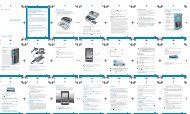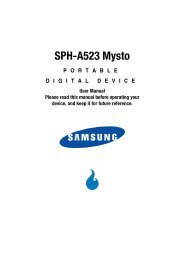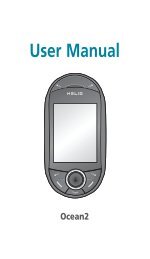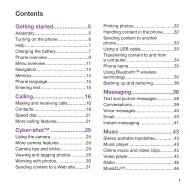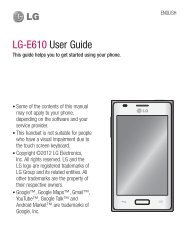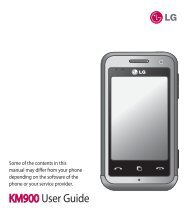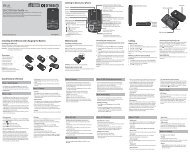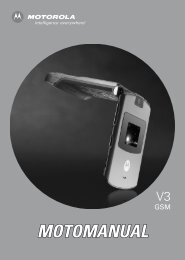T-Mobile SGH-T869 Galaxy Tab 7.0 Plus User ... - Cell Phones Etc.
T-Mobile SGH-T869 Galaxy Tab 7.0 Plus User ... - Cell Phones Etc.
T-Mobile SGH-T869 Galaxy Tab 7.0 Plus User ... - Cell Phones Etc.
Create successful ePaper yourself
Turn your PDF publications into a flip-book with our unique Google optimized e-Paper software.
International Cohort Study on <strong>Mobile</strong> Phone <strong>User</strong>s (COSMOS)<br />
The COSMOS study aims to conduct long-term health monitoring<br />
of a large group of people to determine if there are any health<br />
issues linked to long-term exposure to radio frequency energy<br />
from cell phone use. The COSMOS study will follow<br />
approximately 300,000 adult cell phone users in Europe for 20 to<br />
30 years. Additional information about the COSMOS study can be<br />
found at http://www.ukcosmos.org/index.html.<br />
Risk of Brain Cancer from Exposure to Radio Frequency Fields<br />
in Childhood and Adolescence (MOBI-KIDS)<br />
MOBI-KIDS is an international study investigating the relationship<br />
between exposure to radio frequency energy from<br />
communication technologies including cell phones and brain<br />
cancer in young people. This is an international multi-center<br />
study involving 14 European and non-European countries.<br />
Additional information about MOBI-KIDS can be found at<br />
http://www.creal.cat/programes-recerca/en_projectes-creal/<br />
view.php?ID=39.<br />
Surveillance, Epidemiology, and End Results (SEER) Program<br />
of the National Cancer Institute<br />
The National Cancer Institute (NCI) actively follows cancer<br />
statistics in the United States to detect any change in rates of<br />
new cases for brain cancer. If cell phones play a role in risk for<br />
brain cancer, rates should go up, because heavy cell phone use<br />
has been common for quite some time in the U.S. Between 1987<br />
and 2005, the overall age-adjusted incidence of brain cancer did<br />
not increase. Additional information about SEER can be found at<br />
http://seer.cancer.gov/.<br />
<strong>Cell</strong> Phone Industry Actions<br />
Although the existing scientific data do not justify FDA regulatory<br />
actions, the FDA has urged the cell phone industry to take a<br />
number of steps, including the following:<br />
Support-needed research on possible biological effects of RF for<br />
the type of signal emitted by cell phones;<br />
Design cell phones in a way that minimizes any RF exposure to the<br />
user; and<br />
Cooperate in providing users of cell phones with the current<br />
information on cell phone use and human health concerns.<br />
Reducing Exposure: Hands-Free Kits and Other<br />
Accessories<br />
Steps to Reduce Exposure to Radio Frequency Energy<br />
If there is a risk from being exposed to Radio Frequency (RF)<br />
energy from cell phones — and at this point we do not know that<br />
there is — it is probably very small. But, if you are concerned<br />
about avoiding even potential risks, you can take a few simple<br />
steps to minimize your RF exposure.<br />
Reduce the amount of time spent using your cell phone;<br />
Health and Safety Information 209



